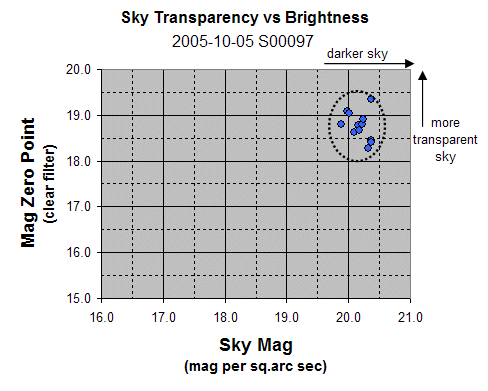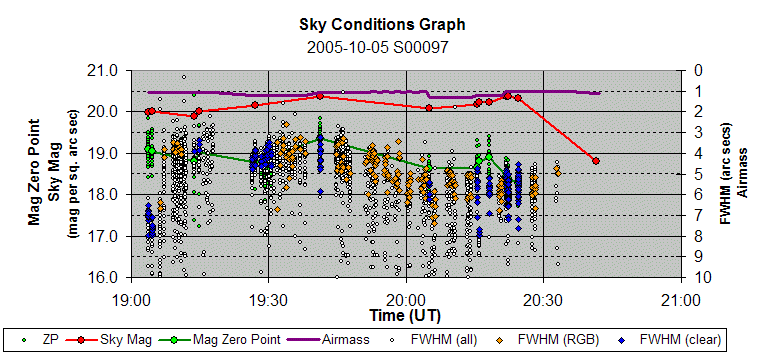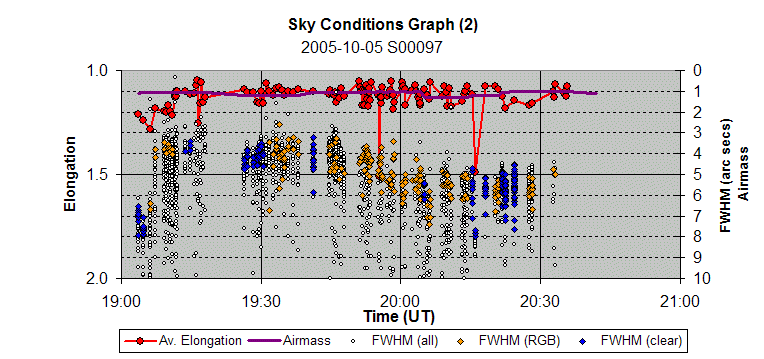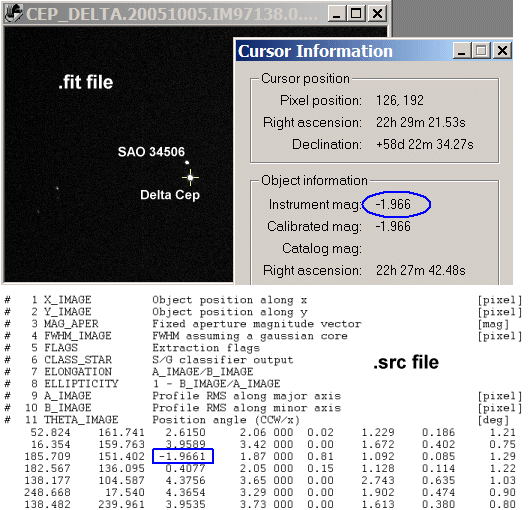David's Astronomy Pages
CCD Image Notes - Session 97
(2005-10-05)
Notes
(S96)
Notes
(Main)
Home
Page
Notes
(S98)
David's Astronomy Pages
|
Notes (S96) |
Notes (Main) |
Home Page |
Notes (S98) |
Notes from CCD Session 97 (S00097) Sky Condition Graph Workflow - Delta Cepheid Magnitude Analysis >
| Sky Conditions Chart (S97) |

|

|

|
|
Notice |
Back to Top
I'm currently attempting to track the variation
of the classic cepheid variable 'Delta Cepheid' using CCD camera as part of a
wider project examining the astronomical distance ladder. Three
factors make this more difficult than some other variable stars.
a) The field of view of my CCD Images of Delta Cepheid are too small to contain
any suitable reference stars.
This requires taking separate images of reference stars.
b) Sky quality at my location isn't generally reliable enough for all-sky
photometry
This introduces more uncertainty when comparing reference stars in one image
with the variable star in another.
c) There are insufficient offset stars on the CCD image to obtain a plate
solution and prevents using more automated methods of photometric data
reduction. This is because Delta Cepheid is a reasonably bright star and
exposure times have to be restricted in order to keep pixel values within the
linear range of my ST-7e CCD camera.
The solution I've adopted is to take batches of images where I alternate between taking sets of Delta Cepheid images (3x 0.3s V, 3x0.3s R, 3x1s B) and sets of Reference Star - SAO 34542 images (also 3x 0.3s V, 3x0.3s R, 3x1s B). B-V colour value of SAO 34542 is somewhat lower that that of Delta Cepheid. This may introduce errors and require additional correction, however at present I'm working Delta Cepheid & SAO 34542 at low airmass values (<1.10) and will assume that corrections can be ignored.
| V Star | SAO 34508 | (Delta Cepheid) | V Mag, ~4.1 | B-V 0.87 | |||
| K Star | SAO 34506 | V Mag 6.27 | B-V -0.02 | ||||
| C Star | SAO 34542 | (Alpha Lacertae) | V Mag 3.78 | B-V 0.03 |
For data reduction the workflow I'm using is summarised as follows:
1) Dark & Flat Field correct images
(<< CCDSoft >>)
- Image / Image Reduction according to normal procedure
2) Build a List of Images with key data (<<
Utility & Excel >>)
- extract image details (Image Num, Date/Time, Exposure, Filter) from each FITS
image
- place details in a Spreadsheet.
Image details can be collected manually using CCDSoft / View / File Information,
but having an automated method of extracting this data to a Tab delimited file
saves a lot of effort. I have a home build program that extracts this data from
each FITS image taken during an observing session.
3) Pre-Analyse
folders of images (<< CCDSoft >>)
- goto CCDSoft/Research/Analysis Folder of Images/Pre-Analyze.
- From Data Analysis window, select Folders and add the folder of
interest.
- click Start
This generally won't achieve any plate solutions, but will perform photometry on
star objects, placing results in a .SRC file in the same folder as images.
Occasionally CCDSoft won't proceed with a certain image if it feels there aren't
enough star-like objects. However it still produces the .SRC file if run
using Data Analysis tool (Note that if you perform autoastrometry on an
individual file it won't produce the .SRC file under these circumstances).
4) Collect Instrumental Magnitudes for V, C
& K stars ( << CCDSoft, Text Editor, & Excel >>)
- open CCDSoft, have View/Cursor Information tab open
- open each .FIT/.SRC file pair.
- position cursor over V Star, read instrument mag value
- goto the associated .SRC file (text editor) and copy the equivalent
Instrumental Mag value to clipboard
- past mag value into spreadsheet
- repeat for K star
- repeat process for C star images.

|
If there is no doubt which is the brightest star in an image (for my images Delta Cepheid and SAO 34542 were each the brightest star in their respective field & the only star with negative instrumental past mag values), it is feasible to directly copy the instrumental mag value from .src file without reference to the Fits file, but if in doubt always check. (values for the dimmer K star had to be individually checked with the Fits image to esnure correct value was being extracted).
5) Average Instrumental Mags by filter and
set (<< Excel >>)
- average instrumental mags by filter for each set of 3 images pen CCDSoft,
have View/Cursor Information tab open
- associate average instrumental mag from adjacent C star set to each V/K star
set.
(this could be the set immediately before, the set immediately after or the
average of the sets before & after)
6) Calculate Calibrated Mags for V and K Stars
(<< Excel >>
- calculate Calibrated Mag for V Star (Delta Cepheid)
using the equation
CalMagV = RefMagC - (RawMagC-RawMagV)
- calculate Calibrated Mag for K Star (control
star) using the equation
CalMagK = RefMagC - (RawMagC-RawMagK)
Calibrated Mags can be calculated for both
individual V/K star images and the average set. The Standard Deviation of
Calibrated Mags from each individual image in a set provides a guide to the
measurement uncertainty associated with the average Calibrated Mag (though not
the total level of uncertainty).
Back to Top
| This Web Page: | CCD Image Notes - (2005-10-05) |
| Last Updated : | 2015-05-16 |
| Site Owner : | David Richards |
| Home Page : | David's Astronomy Web Site |